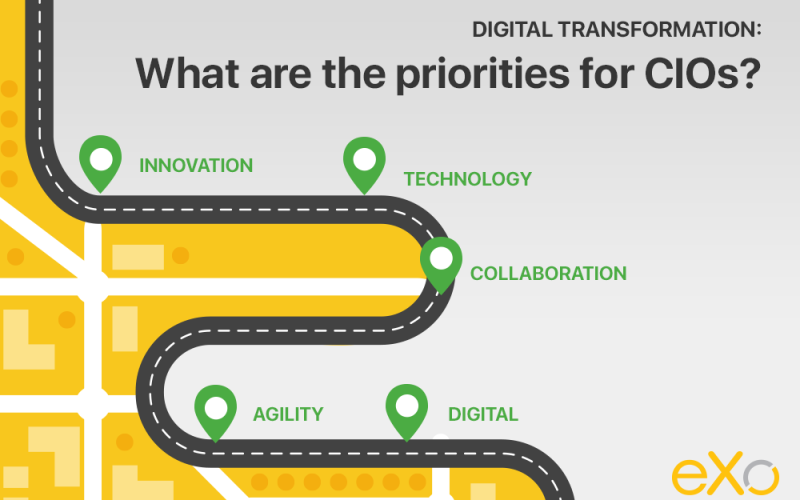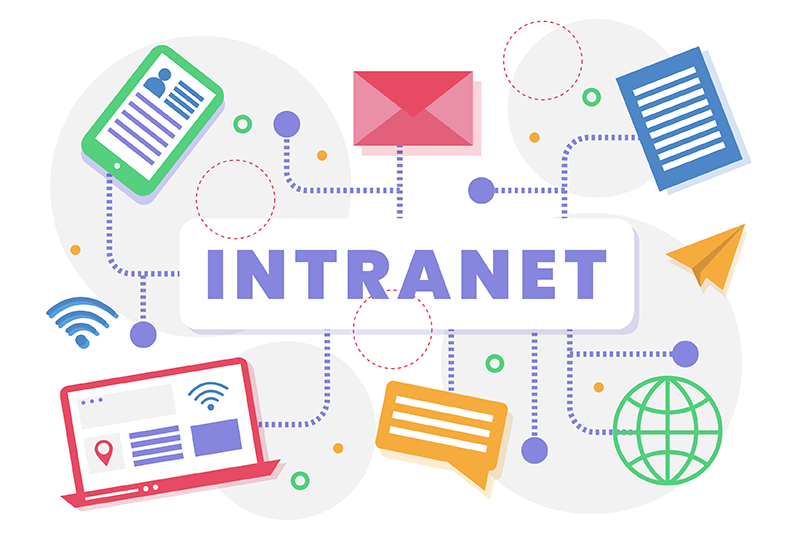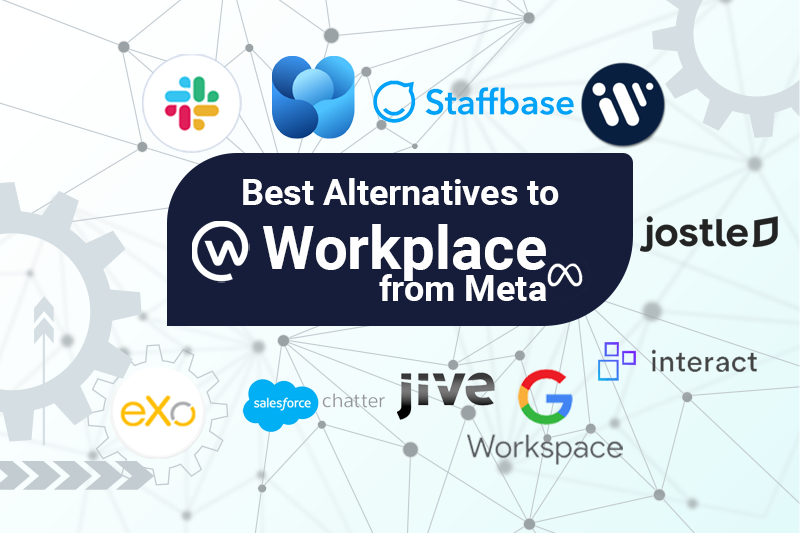- Brahim Jaouane
- April 19, 2017
Digital Transformation: What are the priorities for CIOs?
It is now well-established that CIOs have a key role to play in the digital transformation of their organizations, so where do we start?
Depending on the maturity of the organizations, their affinity for technology and their ability to embrace change, the task can be titanic. It is therefore necessary to establish a clear roadmap based on CIO priorities before launching.

Content
Unlocking technology locks
First of all, to get back into motion, you have to have your hands free. However, many IT departments are crumbling under a heavy and heterogeneous legacy of more or less critical historical applications. They are so expensive and complex to maintain that departments sometimes refuse to touch them.
A Forrester study suggests that CIOs spend 72% of their budgets on existing problems and only 28% on new projects and innovation.
This is the first status quo to challenge. To do so, two-speed IT is sometimes desirable. Older systems, often at the heart of historical businesses, remain in place while modern systems are launched to address digital initiatives. For these new systems, the cloud must not be ignored as a vector of agility, even though it forces CIOs to define their priorities and rethink how they plan and deliver projects. Incorporating the expertise of hiring CIO can offer strategic insights and direction in optimizing budget allocation and balancing existing infrastructure maintenance with innovative digital initiatives.
By freeing themselves from the constraints and cumbersome nature of the old systems, they can reduce the time it takes to market new products and services and to launch new experiments.
But sometimes, making two systems co-exist is not an option. When the core of the business requires access to a central system or budgetary constraints simply limit investment in new systems, it is necessary to renovate the existing ones.
It is not a question of rewriting them entirely, but rather of deconstructing them gradually, taking the opportunity to remove the dependence on historical vendors and reinvest the savings in new technologies.
This renovation should reimagine the information system as a set of services that can be queried by APIs.
Building a foundation for innovation
In the future, IT leaders must think of their information system as a platform. That is, not just as a well-oiled machine that runs established processes, but rather as a technological foundation enabling them to take advantage of their resources dynamically.
In this context, an API strategy is usually required. Business data must be easily searchable, with interoperable technologies to unlock their potential.
The use of these APIs must be carefully tracked. Indeed, you must be able to measure absolutely all the calls to the APIs, obtaining analytics and intelligence in near real time about the needs and behaviors of the users.
These capacities must be planned and thought out from the outset in the technological foundation platform, and they need to be leveraged with every new digital initiative.
The APIs therefore constitute the unique interface for the exchange between the different processing systems and the databases. They must be as decoupled as possible, for example by adopting a micro-services architecture.
APIs must also be accessible externally, especially via the Web and leveraging interoperability formats and protocols. They can then meet the requirements of digital business by allowing new software services or value-added applications to be built for customers, for example.
The opening of APIs to third parties also makes it possible to widen your outlets and value chain. Indeed, third-party companies that develop applications on the platform using APIs form an ecosystem. This is the case in app stores, where developers are invited to submit their applications. They are neither customers nor subcontractors, but their applications create new possibilities without, however, being able to intervene. In this model, the owner of the platform can monetize its ecosystem.
Thus, investing in an API strategy is opportunity for IT departments to switch from a cost center to a profit center and show a clear return on investment.
Embrace agility
Digital innovation requires a degree of agility that is not necessarily present in all IT departments. Where benchmark values used to be security and stability, risk and change are now necessary.
Digital transformation involves remodeling the organization to make it agile, innovative and fundamentally customer-oriented. But just bringing in more technology is not enough.
You must act on the value chain, and that begins with reviewing the customer experience as a whole. Digital marketing teams need to understand who these digital customers are, their differences, expectations, behaviors and affinities.
To do this, they must be able to scrutinize and tag customer journeys and then analyze what guides purchasing decisions. The technological foundation must enable them to understand frictions or gaps and identify new opportunities.
This will result in multiple initiatives run in trial-and-error mode. Whether it’s developing mobile-friendly sites or portals, defining new interfaces for connected customers or launching a marketplace, you’ll need to take a small step forward and analyze what works and what does not. Step, adjust and repeat.
To meet this challenge, IT leaders need to rely on automation and continuous software delivery chains and flexible, reusable environments such as cloud and container services.
Enabling the Culture of Collaboration
Digitizing the entire customer experience requires close collaboration across departments. For example, if you have to set up a program of reviews via social media, the support of your digital marketing team will be essential. And if you need to set up an smart bot that automatically guides or solves customer support requests, working with your customer support team will be required.
In highly hierachical organizations with numerous silos, it will be necessary to evolve certain aspects of the corporate culture to allow everyone to overcome the cumbersome processes and break the barriers to communication.
It is crucial to allow internal collaboration and to build multidisciplinary teams from different functions in the company.
By providing the right tools and sufficient attention, CIOs can create the necessary conditions to make the organization not only communicative and collaborative, but innovative. Indeed, a culture of openness will encourage employees to share their ideas and to propose solutions or hypotheses, which the company has to be able to listen to so it can launch new initiatives.
Finally, organizations will increasingly rely on external collaboration with providers or suppliers because the diversity of digital initiatives and the skills they require will be important.
Here again, technologies such as enterprise social networks and collaborative platforms exist, and it will be up to the IT leaders to ensure that they are properly integrated into the information system, with the same spirit of agility and user satisfaction as in the customer-facing projects.
Staying at the edge
One of the reasons it is better to have an iterative “fail-fast” approach for digital-transformation initiatives is that working on a project for more than six months means it could be obsolete once completed.
Indeed, the exponential acceleration of technological advances obliges digital-transformation actors to keep a constant watch on innovations, including in sectors different from their own. Indeed, technological breakthroughs are accelerating and doing so beyond the boundaries of industry sectors.
Take artificial intelligence: after beating champions at chess and Go games, it is now exploited in medical diagnoses, autonomous vehicles, etc. And it is a safe bet that it finds a place in your industry.
Beyond just watching, you must be able to implement these technologies, which require skills that are increasingly specialized and often rare in the labor market. Here, we find the challenge of collaborating with the HR department, especially for recruiting talent.
Moreover, IT managers must invest heavily in the ongoing training of their staffs and encourage the transfer of skills within technical teams.
The advent of cloud-based solutions is another example of technological advances that are shifting skills within IT departments. The tasks that network and system administrators traditionally performed, such as physical administration of servers and maintenance of infrastructure, are now supported by cloud service providers, forcing CIOs to retrain their staff before they become obsolete.System administrators are the superheroes of any organisation. They work hard to keep our systems running smoothly, and we often take their efforts for granted.
This year, take a moment to show your appreciation for your system administrator on the occasion of SysAdmin Day and thank them for keeping your systems up and running.
The Digital CIO
Whatever the approach, joining their organizations’ digital transformations represents a transformation for CIOs themselves. It is their duty to move from a support role to a catalyst of value. They will have to show great technological mastery and break with traditional schemes by being proactive, agile and iterative. Efficiency needs to be replaced by innovation imperatives, collaboration must go beyond hierarchies, user experience must be at the forefront, and internal skills management must become a concern for everyday life. In short, the digital CIO will emerge only from a deep shift in mindset.
eXo Platform 6 Free Datasheet
Download the eXo Platform 6 Datasheet and
discover all the features and benefits
discover all the features and benefits
- Tags: Digital workplace, Future of work, workplace
Rate this post
I am a Digital Marketing specialist specialized in SEO at eXo Platform.
Passionate about new technologies and Digital Marketing.
With 10 years' experience, I support companies in their digital communication strategies and implement the tools necessary for their success.
My approach combines the use of different traffic acquisition levers and an optimization of the user experience to convert visitors into customers.
After various digital experiences in communication agencies as well as in B2B company, I have a wide range of skills and I am able to manage the digital marketing strategy of small and medium-sized companies.
Related posts
- All
- eXo
- Digital workplace
- Employee engagement
- Open source
- Future of work
- Internal communication
- Collaboration
- News
- intranet
- workplace
- Knowledge management
- Employee experience
- Employee productivity
- onboarding
- Employee recognition
- Change management
- Cartoon
- Digital transformation
- Infographic
- Remote work
- Industry trends
- Product News
- Thought leadership
- Tips & Tricks
- Tutorial
- Uncategorized
Leave a Reply
( Your e-mail address will not be published)



Thanks for sharing. Your article is insightful to me. It is not easy for a team to switch tools. What CIO can do is to choose the right tool and make sure it is implemented.